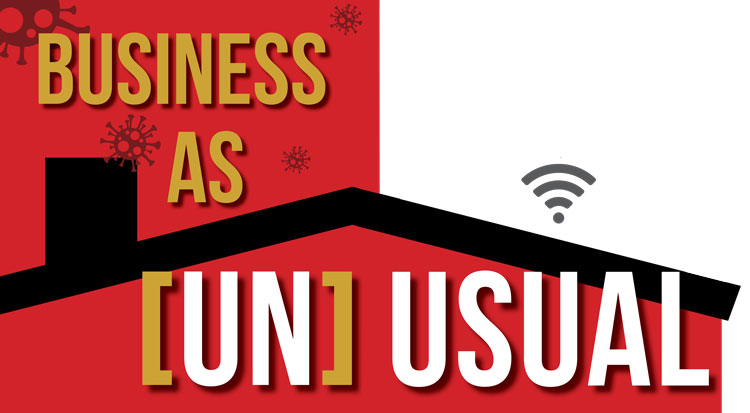Will the COVID-19 pandemic fundamentally remake the legal industry?

Photo illustration by Brenan Sharp/Shutterstock
In late February, the University of Pennsylvania Carey Law School held a Law 2030 conference focused on the myriad challenges the legal profession was likely to face in the next decade and how it could adapt to combat them.
Soon after, the spread of deadly COVID-19 forced law firms and the justice system to rapidly evolve in ways that conferencegoers had predicted would take years to come to fruition.
Shelter-in-place orders and social distancing guidelines necessitated that an industry known for being slow to embrace technology quickly shift to remote working and use the tools needed to do so effectively. Courts also furiously worked to implement videoconferencing and other electronic solutions to keep providing forums for litigants to resolve disputes amid courthouse closures and the suspension of jury trials.
The legal profession endeavored to comply with the various pandemic-related requirements while encountering the beginning of what is likely to be a prolonged economic downturn due to much of global commerce screeching to a halt.
This confluence of events sparked some legal industry observers to predict that the many technological changes being adopted will persist beyond COVID-19, as will the utilization of remote working. Meanwhile, others have suggested the widespread upheaval will provide fuel for state reviews of whether to open up the legal marketplace to alternative business structures and nonlawyer practitioners.
Big promises, mixed results
Of course, many people made similar prognostications a decade ago, when it seemed the Great Recession would fundamentally and radically transform the legal industry. Ultimately, experts suggest such large-scale changes were only partially achieved.

In June, Michigan Supreme Court Chief Justice McCormack swore in a cohort of law students via a Zoom conference. Photo courtesy of the Michigan Supreme Court; Shutterstock.
Predictions that the U.S. would join Australia and the United Kingdom in permitting alternative business structures in the law did not come true. The American Bar Association’s Commission on Ethics 20/20 carefully studied whether to recommend revisions to the ABA policy prohibiting nonlawyer ownership of law firms, but ultimately decided against doing so amid opposition from many in the industry.
However, law firms’ approach to client billing was one area of major reform sparked by the last significant economic downturn, says Susan Hackett, the former longtime general counsel of the Association of Corporate Counsel. Firms started to shift toward billing clients based on the value of the services they were providing, rather than just by the hour, a trend driven in part by clients seeking to cut back their legal expenses and exert more control over their matters.
The legal industry also began to embrace technologies that made some attorney work more efficient, allowing lawyers to spend more time on higher-level tasks. “It brought people to the table to look at doing things differently who had never thought they would sit at that table before,” says Hackett, now CEO of Legal Executive Leadership.
Kent Zimmermann, a consultant at Zeughauser Group who advises law firm leaders, agrees some firms responded to the trying financial times by permanently altering their approach to billing and technology utilization. But others only revised their business model to weather the recession and felt the reforms would not serve them well economically in the long run. That’s why he says the Great Recession’s impact on legal was ultimately mixed.
“I do think many firms kind of snapped back to doing things the way they did before the financial crisis, but I think some others found religion and the benefits to be worth continuing,” Zimmermann says.
‘Forced experimentation’
Zimmermann and Jennifer Leonard, who heads Penn Law’s Future of the Profession Initiative, are among the legal professionals who think the COVID-19 pandemic will produce greater transformative effects.

Jennifer Leonard: “It is really fundamentally disrupting overnight every single component of the legal system, and that is very different than 2008-2009.” Photo courtesy of University of Pennsylvania Carey Law School.
They both note that while the Great Recession was a substantial shock to the economic system, COVID-19 has resulted in the sudden upheaval of society at large. This includes changing how members of the public can access the court system or connect with a lawyer.
“It is really fundamentally disrupting overnight every single component of the legal system, and that is very different than 2008-2009,” says Leonard, who is also Penn Law’s chief innovation officer. “I think it creates enormous opportunities for changing many of the ways we work as lawyers, the ways we provide legal services to our clients and also the ways the justice system as a whole works.”
In the short term, Leonard says the pandemic has resulted in massive “forced experimentation.”
For instance, COVID-19 prompted law firms to quickly adopt technology more common in some other business sectors in order to allow attorneys and staff to work remotely. Video and audioconferencing tools, particularly Zoom, are being used widely for a variety of purposes. These include firm and client meetings, as well as webinars.
Firms have also been utilizing videoconferencing technology to conduct litigation in a remote fashion. Littler Mendelson, a global law firm representing employers, produced training videos to help its attorneys who have needed to conduct depositions, mediations and witness preparation via video.
Scott A. Forman, a Miami-based Littler shareholder, says he expects remote litigation will continue beyond COVID-19. “I anticipate that folks who were resistant to remote meetings and feeling that everything needed to be in person, including depositions, that that resistance will dissipate as time goes on and people get used to this new normal,” Forman says.
Tools that make it easy for lawyers at a firm to collaborate while working from home also have gained traction. Dave Kinsey, whose Phoenix-based Total Networks assists law firms and other businesses with their technology needs, points to the rise in popularity of Microsoft Teams. It permits attorneys to send instant messages to one another, share files and edit documents at the same time as colleagues. Microsoft Teams also permits lawyers to conduct video and voice calls. “I think law firms have come a long way in wanting to be very tech-savvy,” says Kinsey, president and owner of Total Networks.
Shift to the cloud
Perhaps unsurprisingly, the pandemic also prompted more law firms to move their operations to the cloud, something forward-thinking legal outfits like international firm Rimon Law did long ago.

Michael Moradzadeh: “I think this painful experience will push a lot of people to ask, ‘Why aren’t we in the cloud?’” Photo courtesy of Rimon Law.
Michael Moradzadeh, founding partner and CEO of Rimon Law, says “it’s reckless in some ways” for a law firm not to be cloud-based in a climate where remote working is essential. He and others expect more firms will move to the cloud in the months to come.
“I think this painful experience will push a lot of people to ask, ‘Why aren’t we in the cloud?’” says Moradzadeh, who is based in Silicon Valley. “The argument that it is not secure is just outdated at this point.”
“I have a feeling we are going to see the removal of a lot of servers that are still in some small-to-midsize firms because of this,” adds Adriana Linares, a New Orleans-based legal technology consultant.
She says there are also a number of legal technology service providers who have yet to move to the cloud, making it more difficult for lawyers utilizing their software to effectively work remotely. Examples of such tools she highlights are estate planning, real estate closing and litigation support software. “I hope those companies start to develop cloud-based services based on feedback from their clients, or I hope their clients develop alternatives in case this ever happens again,” says Linares, owner of LawTech Partners and the San Diego County Bar Association’s technology and practice management adviser.
Teleworking won’t go away

Adriana Linares: “I have a feeling we are going to see the removal of a lot of servers that are still in some small-to-midsize firms because of this.” Photo courtesy of LawTech Partners.
Experts also think widespread remote working itself will remain common in the legal industry beyond COVID-19. One reason they predict this development is because firms’ quick transition to having almost all lawyers and staff work off-site was smoother than anticipated.
A Loeb Leadership survey of law firm leaders this spring found that 98% of the 136 respondents reported at least a moderate amount of success in rapidly moving their employees to a home office, with 77% of respondents saying they have been highly successful.
“It is hard to put the genie back in the bottle if you have been running a business successfully for two to three months with every staff member out of the office,” said Ben Allgrove, a London-based Baker McKenzie partner, during an interview in the spring.
The initial economic impact of the coronavirus, which prompted firms to begin layoffs and furloughs, also has given legal services providers seeking to cut costs an incentive to have more employees work remotely so they can reduce their physical footprints.
Zimmermann notes that real estate is normally a law firm’s second-largest expense behind lawyer compensation, and he says he has spoken to several law firm managing partners and chairs who say they think their firms will occupy less real estate moving forward, perhaps materially less. “There was already some movement in that direction, but I think this will accelerate momentum toward less big corner offices [and] more flexible arrangements in more firms for more people,” Zimmermann says.
Additionally, Bill Karns, co-founder of Karns & Karns in Los Angeles, believes firms that remain supportive of remote working after the pandemic will have an advantage in recruiting. “Employees are going to want to go to law firms that allow them to work from home a day a week or two days a week,” he says.
Regulatory reform efforts
Meanwhile, the rapid spread of COVID-19 came amid several states’ efforts to overhaul regulation of the legal industry with the primary goal of strengthening access to justice. Task forces launched by supreme courts or state bars in several U.S. jurisdictions have examined how to make it easier for technology-driven legal services providers to operate and whether to eliminate prohibitions regarding nonlawyer ownership of law firms. Regulatory reform supporters say they believe the coronavirus and its aftermath will create additional momentum for such efforts because the many legal issues associated with COVID-19 will further exacerbate the justice gap.

Michigan Supreme Court Chief Justice Bridget Mary McCormack: “You need to get to the tipping point before something sticks.” Photo courtesy of the Michigan Supreme Court.
“I think the demand for legal services will rise, and at the same time I think the ability of lawyers to sustain their practices under the current models are going to be crippling in some cases,” says Jayne Reardon, executive director of the Illinois Supreme Court Commission on Professionalism.
She and Scott Bales, the former chief justice of the Arizona Supreme Court, say the pandemic has also highlighted the essential role technology plays in broadening access to justice.
For example, legal innovators have worked in recent months to develop mobile applications that allow members of the public to remotely submit court forms. Legal technologists also have created tools to help consumers and businesses determine if they are eligible for benefits included in the coronavirus-related federal stimulus legislation signed into law.
Bales, now the executive director of the Institute for the Advancement of the American Legal System, says restrictions on who can own law firms have historically inhibited technological advances by limiting the investment needed for testing out innovative approaches to delivering legal services.
“I think, over time, opening up the provision of services by entities where lawyers can combine in ownership with nonlawyers has the greatest potential for technological changes and bringing capital into the legal services industry in a more direct way than is now occurring,” Bales says.
A similar argument was made in a white paper the Stanford Center on the Legal Profession released in late April, highlighting what it says would be the many benefits of reforming ABA Model Rule of Professional Conduct 5.4, which prohibits nonlawyers from owning or investing in law firms.

Photo of Utah Supreme Court Justice Constandinos “Deno” Himonas by Kelly David Sansom.
Utah is the state that appears closest to broadly opening up its legal marketplace. In late April, the Utah Supreme Court proposed a series of wide-ranging regulatory reforms that included permitting nonlawyers to own or invest in law firms. The court planned to decide how to proceed on its proposals after receiving public comments through July 23. “This pandemic has highlighted the need for regulatory reform,” Utah Supreme Court Justice Constandinos “Deno” Himonas says.
Meanwhile, sandbox proposals from applicants who believe they could provide low-cost or no-cost legal services addressing issues stemming from COVID-19 were to be considered for expedited approval.
Himonas says this provision was included in light of the pandemic creating significant demand for legal services in a variety of practice areas, including those where litigants are often self-represented.
Courts streaming video
Judicial leaders throughout the U.S. also have helped courts join the broader legal industry in quickly expanding their use of technology in response to COVID-19.
In early April, the Texas Supreme Court for the first time livestreamed an oral argument session in which the lawyers and some of the justices appeared remotely.
Meanwhile, the state’s trial courts held video-powered hearings in more than 160,000 civil and criminal cases from late March to mid-June, according to David Slayton, administrative director of Texas’ Office of Court Administration. Texas Supreme Court Chief Justice Nathan L. Hecht says this speedy adoption of technology would have been unimaginable prior to the COVID-19 outbreak.

Texas Supreme Court Chief Justice Nathan L. Hecht: “The pressure on the industry to improve the platforms to meet the needs of the justice system is going to be enormous.” Photo by Lauren Garrison, Upstream Communications.
“I know if we had tried to get trial courts in Texas to videoconference more, we would be working at it for years before we made any discernible progress,” Hecht says.
By mid-June, more than 40 state supreme courts had responded to in-person arguments being canceled by holding remote hearings, according to Fix the Court.
While the report said federal courts were not as quick to adapt, it noted that several U.S. appeals courts had permitted livestreaming by mid-April. Additionally, the U.S. Supreme Court livestreamed oral arguments for the first time in May using teleconference technology.
Fix the Court reported that more than 880,000 people clicked on the audio feed of the arguments in President Donald Trump’s tax records case, and the organization conducted a poll that found 70% of respondents would like the live audio to continue post-pandemic.
In a June letter addressed to Chief Justice John Roberts, ABA President Judy Perry Martinez encouraged the Supreme Court to continue livestreaming oral arguments during the upcoming October term.
Hecht, who is also president of the Conference of Chief Justices, expresses confidence videostreaming technology will be used in Texas courts even after the current pandemic. He predicts other states will likely do the same because of the benefits the technology provides lawyers and court personnel who live in geographically large states or rural areas.
For example, an April videoconference of his court’s oral arguments saved lawyers in a case from having to make a roughly 1,200-mile round-trip trek from El Paso to Austin for a brief appearance. Additionally, Hecht says tech platforms have greater incentive now to make their tools easier for courts to use. “With the whole American justice system running downhill toward these changes, the pressure on the industry to improve the platforms to meet the needs of the justice system is going to be enormous,” he says.
COVID-19 also has prompted courts to expand their use of e-filing, e-service and online dispute software, among other tools. The pandemic sparked Michigan to work to more quickly to expand statewide an online dispute resolution service for some civil disputes and small claims matters, Michigan Supreme Court Chief Justice Bridget Mary McCormack says. She envisions courts across the country will pursue such technological innovations beyond the near term.
“You need to get to the tipping point before something sticks,” McCormack says. “That tipping point is coming very quickly.”
See also: ABA’s Practice Forward group will help lawyers navigate rapidly changing profession
This story was originally published in the August/September 2020 issue of the ABA Journal under the headline: “Business as [Un]usual: Will the COVID-19 pandemic fundamentally remake the legal industry?”



